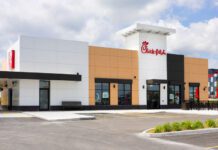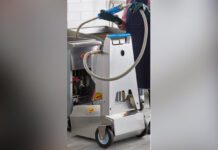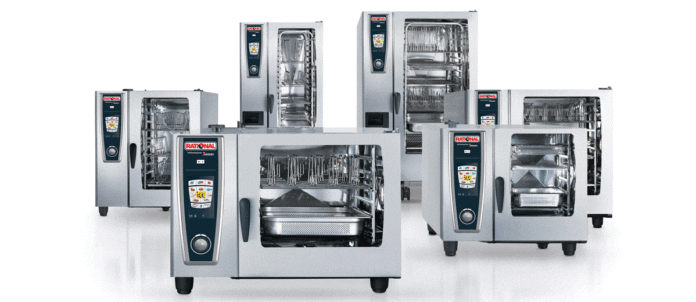By: Denise Deveau
[dropcap size=big]W[/dropcap]hen it comes to the big-ticket kitchen items, it’s all about achieving more with less. From fine-dining and quick-service establishments to commissaries and convention centres, equipment buyers are looking to save labour, energy and/or space.
More and more, the solution is to purchase multi-function combi-ovens and kettles or compact blast chillers that speed production. And, monitoring equipment performance and temperature with Bluetooth technology is becoming increasingly popular as safety and energy usage concerns become increasingly important.
“People are looking for things that will reduce their general overhead. But it’s not always about the cheapest. You have to look at the long-term benefits,” says Gary Lummis, president at the Lummis & Co. foodservice consultancy in Fredericton.
Bernard Casavant, a chef and culinary manager for Okanagan College’s Culinary Arts program in Kelowna, B.C. agrees. “The equipment items that operators are really trying to budget for are those that enable less bodies to do the same amount of the work and deliver consistent product,” he affirms.
Combi Power Prevails
Casavant believes combi-ovens are the number-1 trend in foodservice equipment. “More and more restaurants are buying combi-ovens as the price comes down and they become more user-friendly,” he says.
Okanagan College’s new six-tray ovens from Germany-based Rational (approximately $13,000 to $15,000 apiece) not only grill, roast, fry, bake, retherm and smoke, they also offer the latest in communication technologies. “They’re constantly changing the computer boards and upgrading them in response to customer demand,” Casavant says. “The cumbersome part of older models was that banquet chefs had to leave the machine to bring up the information they needed. Now it’s done on the machine’s screen. And, with the average student being so computer savvy, they have no fear of this technology.”
Lummis & Co.’s Lummis also considers combi-ovens to be the biggest contributor to kitchen efficiency, since they can replace five or six machines. “You can even use them to cook french fries. The Convotherm [from U.S.-based Manitowoc], for example, has a feature that combines steam, heat, convection and crisping. It’s hard to tell the difference from deep-fried,” says Lummis.
When the team at the Metro Toronto Convention Centre (MTCC) purchased 12 Rational roll-in combis at $45,000 each, it freed up space and increased efficiency, says Richard Willett, VP, Food and Beverage. The machines were part of a $6-million overhaul of MTCC’s kitchen operations in the summer of 2013. “We didn’t have room to grow, but we put technology into play that helped use the space better,” he says.
Combis were an ideal choice to replace conventional ovens at MTCC. “Not only were they the best choice in terms of the volume of business we do, but they [also] have a [self-cleaning feature], which saves labour. And we can do so much more. We’re looking at smoking with them as well. The sky’s the limit,” says Willett.
The ovens can also be programmed in multiple languages. “We have up to 13 languages in the kitchen, so that feature will come in handy,” the VP explains. “We can also record information on client preferences and save them until the next time, so we can prepare things the exact same way.”
Prep Time
At large-scale operations, puchasing decisions are largely focused on equipment that allows cooks to prep large quantities of food ahead of time, while saving on labour, time and costs, says Luc Bedard, former president of Mississauga, Ont.-based R.E.D. Canada – Restaurant Equipment Distributors of Canada Ltd. “A lot are using combi-ovens in combination with blast chillers to prepare, chill and plate food,” he explains.
Blast chillers not only offer energy efficiency and space savings, but they are a must given stringent health-code requirements for advance meal-prep activities. “You’re not really compliant with HAACP if you’re sticking cooked food in the refrigerator,” Lummis explains. “Blast-chilling is becoming almost mandatory for advanced meal preparation, because you can program it and set hold temperatures. Several manufacturers are doing a decent job in this area, including American Panel and Traulsen.”
MTCC purchased two Italian-made blast chillers from Irinox that are large enough to accommodate roll-in racks. The price per chiller is approximately $120,000. “It’s a huge space-saving option, because we’re not having sauces sitting out in bain-maries [water baths],” Willett says.
Blast chillers aren’t just a necessity for larger facilities. At the newly opened Boulevard Kitchen & Oyster Bar in Vancouver, a HurriChill blast chiller from Ocala, Fla.-based American Panel sits in the prep hall and saves space and labour, while eliminating the need for multiple sinks, says Alex Chen, chef at the Oyster Bar. “The best part is food is always at the proper temperature.”
Steam kettles with chilling functions are also gaining popularity at large-scale commissary operations, says Lummis. Some kettle models from Cleveland, Ohio-based Cleveland and Chicago-based Groen will cook, then rapidly chill product in the kettles via a chilled water circuit in the jacket. Built-in agitators and automatic tilt features are not only convenient but also help to improve worker safety, because the contents don’t have to be stirred and the tilting function replaces the need for lifting.
The kettles are also increasingly being used in healthcare facilities and prisons where larger quantities of foods can be prepped, cooked, chilled and packaged to reduce on-site cooking needs. “Making large amounts of food and freezing it ahead of time means you only have to cook two to four days a week. Nursing-home staff, for example, can simply retherm meals [using rapid-cook equipment] on the floors. It’s a big cost-savings,” says Bedard.
Wash ‘n’ Ware
On the warewashing side, expect to see more low-temperature machines that have less environmental impact and use less chemicals, Okanagan College’s Casavant says. “Footprints are much better now. They used to be big three-tray machines. Now there are a lot of corner and single-rack machines that are very quick,” he says. Where space and budget allows, heat-recovery [is] becoming an increasingly important feature.
Kitchen space was reclaimed at MTCC with the installation of an ergonomically friendly warewashing system — from Burlington, Ont.-based Halton Food Equipment — which captures heat; it’s complemented by a turbo washer for pots and pans from LVO Manufacturing, Inc. in Rock Rapids, Iowa. “The turbo washer alone shrunk our pot-washing area in half,” Willett says.
Technology is creating interesting synergies. For example, operators are investing in temperature-monitoring systems for coolers and freezers that managers can access remotely. “Some systems will even ring a service person if the temperature varies by five or 10 degrees,” Bedard notes. “It’s mostly used by larger operations, like Tim Hortons or St-Hubert, because the cost of a mishap would be very high.”
USB ports and Bluetooth offer operator advantages, too. At the MTCC, major appliances are Bluetooth-enabled, which means management can check the performance at any time, from any location. “The industry is moving in a different direction from a health-and-safety and risk-management perspective,” MTCC’s Willett says, referring to more stringent rules regarding holding temperatures and reporting requirements. “The capacity to extract data quickly on an as-needed basis is essential.”


















